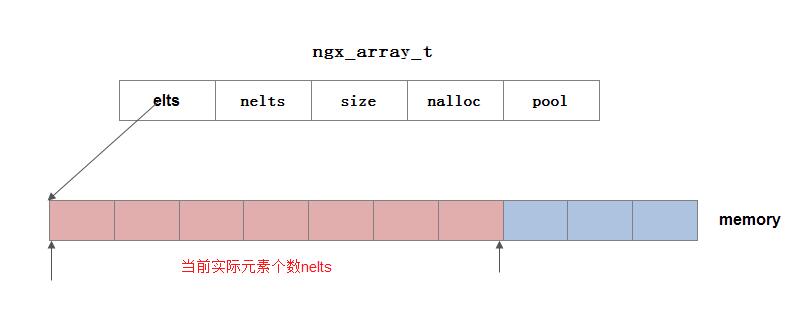core/ngx_array.c(h)源代码分析
本节我们主要讲述一下nginx中数组的实现。
1. core/ngx_array.h头文件
/*
* Copyright (C) Igor Sysoev
* Copyright (C) Nginx, Inc.
*/
#ifndef _NGX_ARRAY_H_INCLUDED_
#define _NGX_ARRAY_H_INCLUDED_
#include <ngx_config.h>
#include <ngx_core.h>
typedef struct {
void *elts;
ngx_uint_t nelts;
size_t size;
ngx_uint_t nalloc;
ngx_pool_t *pool;
} ngx_array_t;
ngx_array_t *ngx_array_create(ngx_pool_t *p, ngx_uint_t n, size_t size);
void ngx_array_destroy(ngx_array_t *a);
void *ngx_array_push(ngx_array_t *a);
void *ngx_array_push_n(ngx_array_t *a, ngx_uint_t n);
static ngx_inline ngx_int_t
ngx_array_init(ngx_array_t *array, ngx_pool_t *pool, ngx_uint_t n, size_t size)
{
/*
* set "array->nelts" before "array->elts", otherwise MSVC thinks
* that "array->nelts" may be used without having been initialized
*/
array->nelts = 0;
array->size = size;
array->nalloc = n;
array->pool = pool;
array->elts = ngx_palloc(pool, n * size);
if (array->elts == NULL) {
return NGX_ERROR;
}
return NGX_OK;
}
#endif /* _NGX_ARRAY_H_INCLUDED_ */下面对ngx_array.h头文件各部分做一个简单的解释:
1.1 nginx中数组数据结构
typedef struct {
void *elts; //存储数据元素的基址
ngx_uint_t nelts; //当前实际的元素个数
size_t size; //每个元素的大小
ngx_uint_t nalloc; //当前所分配的可以容纳的元素个数
ngx_pool_t *pool; //所关联的内存池
} ngx_array_t;请参看下图:

1.2 相关函数声明
//创建一个容量为n,每个元素大小为size的数组
ngx_array_t *ngx_array_create(ngx_pool_t *p, ngx_uint_t n, size_t size);
//销毁数组(这里是将数组占用的空间交还给内存池)
void ngx_array_destroy(ngx_array_t *a);
//增加一个元素到a数组中(这里返回要增加的这个元素的存储位置)
void *ngx_array_push(ngx_array_t *a);
//增加n个元素到a数组中(这里返回这n个新添加元素的起始存储位置)
void *ngx_array_push_n(ngx_array_t *a, ngx_uint_t n);1.3 函数ngx_array_init()
static ngx_inline ngx_int_t
ngx_array_init(ngx_array_t *array, ngx_pool_t *pool, ngx_uint_t n, size_t size)
{
/*
* set "array->nelts" before "array->elts", otherwise MSVC thinks
* that "array->nelts" may be used without having been initialized
*/
array->nelts = 0;
array->size = size;
array->nalloc = n;
array->pool = pool;
array->elts = ngx_palloc(pool, n * size);
if (array->elts == NULL) {
return NGX_ERROR;
}
return NGX_OK;
}这里为数组从pool内存池中分配对应的空间,并初始化数组。
2. core/ngx_array.c源文件
2.1 函数ngx_array_create()
/*
* Copyright (C) Igor Sysoev
* Copyright (C) Nginx, Inc.
*/
#include <ngx_config.h>
#include <ngx_core.h>
ngx_array_t *
ngx_array_create(ngx_pool_t *p, ngx_uint_t n, size_t size)
{
ngx_array_t *a;
a = ngx_palloc(p, sizeof(ngx_array_t));
if (a == NULL) {
return NULL;
}
if (ngx_array_init(a, p, n, size) != NGX_OK) {
return NULL;
}
return a;
}这里首先分配ngx_array_t *数据结构分配内存空间,然后再初始化该数组。
2.2 函数ngx_array_destroy()
void
ngx_array_destroy(ngx_array_t *a)
{
ngx_pool_t *p;
p = a->pool;
if ((u_char *) a->elts + a->size * a->nalloc == p->d.last) {
p->d.last -= a->size * a->nalloc;
}
if ((u_char *) a + sizeof(ngx_array_t) == p->d.last) {
p->d.last = (u_char *) a;
}
}这里将从内存池分配的数据归还给内存池。
2.3 函数ngx_array_push()
void *
ngx_array_push(ngx_array_t *a)
{
void *elt, *new;
size_t size;
ngx_pool_t *p;
if (a->nelts == a->nalloc) {
/* the array is full */
size = a->size * a->nalloc;
p = a->pool;
if ((u_char *) a->elts + size == p->d.last
&& p->d.last + a->size <= p->d.end)
{
/*
* the array allocation is the last in the pool
* and there is space for new allocation
*/
p->d.last += a->size;
a->nalloc++;
} else {
/* allocate a new array */
new = ngx_palloc(p, 2 * size);
if (new == NULL) {
return NULL;
}
ngx_memcpy(new, a->elts, size);
a->elts = new;
a->nalloc *= 2;
}
}
elt = (u_char *) a->elts + a->size * a->nelts;
a->nelts++;
return elt;
}这里主要需要注意的是,在当前数据元素个数达到总容量时,如何分配内存:
- 如果该数组所绑定的内存池可分配的内存正好在原数组空间的后边,且还有剩余的空间可分配,则直接分配即可
if ((u_char *) a->elts + size == p->d.last
&& p->d.last + a->size <= p->d.end)
{
}- 如果该数组所绑定的内存池后续没有空间可分配,则需要在该内存池中另寻另一块空间来分配,并且分配的容量扩大一倍
1.4 函数ngx_array_push_n()
void *
ngx_array_push_n(ngx_array_t *a, ngx_uint_t n)
{
void *elt, *new;
size_t size;
ngx_uint_t nalloc;
ngx_pool_t *p;
size = n * a->size;
if (a->nelts + n > a->nalloc) {
/* the array is full */
p = a->pool;
if ((u_char *) a->elts + a->size * a->nalloc == p->d.last
&& p->d.last + size <= p->d.end)
{
/*
* the array allocation is the last in the pool
* and there is space for new allocation
*/
p->d.last += size;
a->nalloc += n;
} else {
/* allocate a new array */
nalloc = 2 * ((n >= a->nalloc) ? n : a->nalloc);
new = ngx_palloc(p, nalloc * a->size);
if (new == NULL) {
return NULL;
}
ngx_memcpy(new, a->elts, a->nelts * a->size);
a->elts = new;
a->nalloc = nalloc;
}
}
elt = (u_char *) a->elts + a->size * a->nelts;
a->nelts += n;
return elt;
}本函数与ngx_array_push()类似,这里不再赘述。

